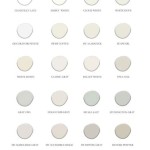Most Popular Neutral Paint Colors 2024
Neutral paint colors continue to dominate interior design trends in 2024, offering versatility, timelessness, and the ability to create a calming and sophisticated atmosphere. The enduring appeal of neutrals lies in their capacity to adapt to various design styles, from minimalist modern to classic traditional, and to serve as a blank canvas for incorporating bolder accent colors and textures. Understanding the nuances of popular neutral shades, including their undertones and how they interact with light, is crucial for achieving the desired aesthetic in any space.
The selection of a neutral paint color extends beyond simply choosing between white, gray, or beige. The color palette encompasses a vast spectrum of shades, each possessing unique characteristics that can dramatically impact the overall look and feel of a room. Considering factors such as natural light, existing furniture, and personal preferences is essential for making an informed decision. This article will explore some of the most sought-after neutral paint colors in 2024, highlighting their defining characteristics and offering guidance on how to best incorporate them into residential and commercial spaces.
The Rise of Warm Neutrals
While cool grays have been a mainstay in recent years, 2024 sees a resurgence of warm neutrals. These colors, characterized by yellow, red, or brown undertones, offer a comforting and inviting ambiance, creating spaces that feel both stylish and welcoming. The shift towards warmer tones reflects a desire for increased coziness and a move away from the stark, sterile aesthetic sometimes associated with cooler palettes. Warm neutrals effectively counteract the coldness of modern architectural features and provide a pleasing contrast to natural materials like wood and stone.
Examples of popular warm neutrals include creamy whites, soft beiges, and greiges with subtle warmth. Creamy whites, such as "Swiss Coffee" or "White Dove," offer a classic and timeless appeal, providing a soft and diffused light that brightens any room. These shades work particularly well in spaces with limited natural light, as they reflect light effectively without appearing too harsh. Soft beiges, like "Accessible Beige" or "Balboa Mist," offer a more grounded and earthy feel, creating a sense of stability and comfort. They are versatile enough to complement a wide range of furniture styles and accent colors. Greiges, which are combinations of gray and beige, strike a balance between warm and cool, offering a sophisticated and adaptable option. A warm-leaning greige, such as "Revere Pewter" or "Edgecomb Gray," can add depth and dimension to a space without sacrificing its overall neutrality.
When selecting a warm neutral, it's important to consider the specific undertones and how they interact with the existing elements in the room. For example, a beige with strong yellow undertones may clash with cooler furniture or artwork. Sampling the paint color in different lighting conditions is crucial for ensuring that the chosen shade complements the existing décor and creates the desired atmosphere. The goal is to create a cohesive and harmonious space that feels both inviting and stylish.
The Enduring Popularity of Gray and Greige
Despite the rising popularity of warmer tones, gray and greige remain significant players in the neutral paint color landscape. These shades offer a sophisticated and versatile backdrop for a variety of design styles, from modern and contemporary to transitional and even traditional. The key to successfully incorporating gray or greige lies in carefully considering the undertones and selecting a shade that complements the existing light and furnishings. Gray, in particular, can range from cool and crisp to warm and inviting, depending on its underlying pigment.
Cool grays, such as "Agreeable Gray" and "Silver Strand," remain popular choices for those seeking a modern and minimalist aesthetic. These shades offer a clean and sophisticated look that pairs well with sleek furniture and metallic accents. However, it's important to use cool grays judiciously, as they can sometimes feel cold or impersonal, particularly in spaces with limited natural light. To counteract this effect, consider incorporating warmer textures and materials, such as wood, leather, or woven textiles, to add a sense of comfort and visual interest.
Greige, as previously mentioned, represents a balanced alternative to purely gray or beige. These versatile shades offer the best of both worlds, providing a neutral backdrop with subtle warmth that prevents the space from feeling too sterile or cold. Greiges like "Pale Oak" or "Manchester Tan" are particularly popular for their adaptability and ability to complement a wide range of furniture styles and accent colors. They work well in both small and large spaces, creating a sense of spaciousness and tranquility. When working with gray or greige, it's essential to consider the undertones and how they interact with the existing elements in the room. Sampling the paint color in different lighting conditions is crucial for ensuring that the chosen shade complements the existing décor and creates the desired atmosphere.
Moreover, the sheen of the paint also plays a crucial role in how a gray or greige appears in a space. Matte finishes tend to absorb light, creating a softer and more muted look, while glossier finishes reflect light, making the color appear brighter and more vibrant. The choice of sheen depends on the desired effect and the specific characteristics of the room. Matte finishes are often preferred for bedrooms and living rooms, while glossier finishes are more suitable for bathrooms and kitchens, where durability and easy cleaning are paramount.
The Importance of Whites and Off-Whites
White and off-white paint colors are foundational to any interior design scheme. They provide a clean, bright, and versatile canvas that can be adapted to virtually any style. White's ability to reflect light makes it ideal for brightening up small or dark spaces, while its neutrality allows other elements in the room to take center stage. The key to selecting the right white or off-white lies in understanding the subtle variations in undertones and how they interact with the surrounding environment.
Pure white, such as "Decorator's White" or "Ultra White," offers a crisp and modern look that is particularly well-suited for contemporary spaces. However, pure white can sometimes feel too stark or clinical, especially in spaces with limited natural light. Off-whites, which contain slight hints of other colors, offer a softer and more inviting alternative. These shades, such as "Simply White" or "Cloud White," provide a subtle warmth that prevents the space from feeling too sterile or cold.
The choice of white or off-white often depends on the desired aesthetic and the existing elements in the room. For example, a warm off-white with yellow undertones can create a cozy and inviting atmosphere, while a cool off-white with gray undertones can evoke a more sophisticated and modern feel. When selecting a white or off-white, it's important to consider the other colors in the room, including the flooring, furniture, and trim. The goal is to create a cohesive and harmonious color palette that complements the overall design scheme.
White and off-white paint colors are not limited to walls. They are also commonly used for trim, ceilings, and cabinetry. When selecting a white for these applications, it's important to consider the overall color scheme of the room and choose a shade that complements the wall color and other elements. For example, a bright white trim can provide a crisp and clean contrast against a warmer wall color, while a softer off-white trim can create a more subtle and cohesive look. Proper preparation and application are crucial for achieving a flawless finish with white and off-white paint colors, as imperfections are often more noticeable than with darker shades. This includes thoroughly cleaning and priming the surface before painting and using high-quality brushes and rollers to ensure smooth and even coverage.
Beyond the specific color choice, understanding the Light Reflectance Value (LRV) of a paint is crucial. LRV measures the percentage of light a color reflects, with 0 being perfectly absorbent (black) and 100 being perfectly reflective (pure white). Selecting paint colors with appropriate LRV values for the specific room and lighting conditions is essential for achieving the desired brightness and ambiance. Darker rooms benefit from higher LRV values, while brighter rooms can handle lower LRV values without feeling dim.
Ultimately, the "most popular" neutral paint colors are subjective and depend on individual preferences and the specific characteristics of each space. However, by understanding the nuances of different neutral shades, including their undertones, LRV, and how they interact with light, homeowners and designers can make informed decisions that create beautiful, functional, and timeless interiors. The current trends leaning towards warmer neutrals suggest a desire for comfort and connection, but the enduring appeal of grays, greiges, and whites highlights the versatility and adaptability of neutral palettes as a whole. Careful consideration and experimentation are key to finding the perfect neutral paint colors to transform any space.

2024 Paint Color Trends Best New Neutrals Porch Daydreamer

Kylie M S 5 Colors Of The Year 2024 Collection Interiors

Is Beige Trendy For 2024 If Not What Color Kylie M Interiors

Best 2024 Paint Colors You Need To Know About Porch Daydreamer

Kylie M S 5 Colors Of The Year 2024 Collection Interiors

The Most Popular Neutral Paint Colors Transforming Interiors In 2024 Agape Home Services

The Best 15 Neutral Paint Colors For 2024 Turquoise Home

Best Neutral Paint Colors In 2024 Simply Diy Home

The Best Neutral Paint Colors Midwest Life And Style Blog

30 Best Neutral Paint Colors 2024 To Brighten A Room For Living Popular Color
Related Posts








